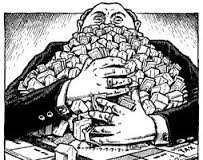Market Imperfections¶
After setting up the simple perfect competition case, building on what we did in an economy with production, we will investigate two situations where markets deviate from the perfect competition case and the first welfare theorem. First, we will look at the case of market power, by considering the monopoly. Then we will look at the case with asymetric information. This lecture is meant to be a gentle introduction to market imperfections.
Benchmark¶
General equilibrium with production, the topic of the previous lecture, assumes that firms are price takers. This leads to a market equilibrium where the first welfare theorem applies. The market equilibrium is a Pareto optimum. This assumption of price-taking behavior works well when a very large number of firms are present. Firms cannot impact the market price by their actions. The possibility of affecting the market price confers to the firm market power and leads to a deviation from Pareto optimality.
Consider the example of an economy for a good \(X\) and a numéraire good \(M\) (with a normalized price to one). Think of the numeraire as money if that helps. For simplicitly assume utility is quasi-linear \(U(X,M) = V(X) + M\), with \(V(X)\) concave, \(V'(0) = + \infty\).
Endowments are \(I_0\) of \(M\), the good \(X\) is produced by one firm at price \(p\). The firm is producing \(X\) with a cost function \(C(X)\). Assume \(C'(0) = 0\).
Todo
Exercise A: Find the equilibrium price and quantity, \(X_T\) if the firm is a price taker and \(V(X) = \sqrt{X}\), \(C(X) = X^2\).
Given production at some price, producer surplus, is given by:
When there are no fixed costs, this is equivalent to profits. Note that if a firm faces a constant marginal cost, producer surplus in a perfectly competitive market equilibrium is zero since price equals marginal cost. With increasing marginal cost (decreasing returns to scale), profits are positive but the marginal unit produced in equilibrium brings in zero profits.
Important
Total welfare in this economy consist of the sum of producer and consumer surplus (see welfare class). This is our benchmark.
Market Power¶
Firms who by their production choices impact the equilibrium price have market power. They can generate more profits relative to the perfect competition situation. They take some of the surplus of consumers, leading to rents. The firm can reduce production, below the quantity which is Pareto optimal in perfect competition. This This leads to an equilibrium price above marginal cost (the price is set when marginal revenue equals marginal cost). This increases profits of the firm.
To understand this strategic behavior, observe that the firm picks \(X\) to maximize
\[\Pi = p(X)X - C(X)\]
The FOC is
\[\frac{d\Pi}{dX} = 0 \iff p'(X)X + p(X) = C'(X)\]
which leads to a choice \(X_{M}\) such that
The left-hand side is marginal revenue while the right-hand side is marginal cost. The first term on the left is the marginal effect of an increase in the quantity. The marginal unit produced brings in \(p(X_{M})\). This effect is the only one showing up when the firm is a price taker. The quantity chosen is such that the price (marginal revenue) is equal to marginal cost.
But a second term is present on the left-hand side. There is an infra-marginal effect on marginal revenue when actions impacprofits of the firm, t the price. When the firm increases quantity, the market price goes down (no Giffen good). Therefore, the revenue it receives from producing what it already produces \(X_{M}\) goes down. This effect is negative since \(p'(\cdot)\) is negative. Overall, marginal revenue is the sum of a positive and a negative term, hence lower than when the firm is a price taker. At the price-taker quantity produced, the marginal revenue is lower than marginal cost. The firm will reduce the quantity produced to restore equality and maximize profits.
Todo
Exercise B: Find the equilibrium price and quantity, \(X_{M}\), if the firm strategically manipulates the price and
\(V(X) = \sqrt{X}\), \(C(X) = X^2\). Show in a graph that situation relative to the price taker situation.
Todo
Exercise C: In Exercise B, find the expression for the equilibrium price as a function of the price elasticity of demand. Analyze that situation.
The Inverse Problem It is also possible to write the strategic price manipulation problem in terms of a choice over price rather than quantity. This leads to the same result but viewed from the explicit choice of prices. For example, let \(X(p)\) be demand (instead of inverse demand). With constant marginal cost, we get
The FOC is
which can be solve for the optimal price given a demand function \(X(p)\).
A few market configurations are associated with market power. We cover only the monopoly.
Monopoly¶
A monopoly exists when one firm is in a market and that firm exploits market power. If demand is not perfectly elastic, the monopoly can manipulate the price strategically by changing its production level and increase profits.
At the optimal level of production \(X_{M}\) we have
\[p(X_{M}) + p'(X_{M})X_{M} = C'(X_{M})\]
and therefore if \(p'(X_{M})<0\), then \(p(X_{M}) > C'(X_{M})\).
The monopoly picks a production level which leads to a higher price than marginal cost. If production does not have an impact on the price, the firm is a price taker and produces \(X_{T}\) at \(p(X_{T}) = C'(X_{T})\). Therefore, \(X_{M} < X_{T}\).
The monopoly makes abnormal profits, a portion of which comes from capturing part of the consumer surplus of consumers, what we call the rents. These rents are given by
\[\Pi_{M} = (p(X_{M}) - p(X_{T})) X_{M}\]
Rents reduce consumer surplus for units produced by the monopoly. But these rents are not the source of the welfare loss. The welfare loss occurs on units not produced or consumed, because of the monopoly situation. These units have positive economic value \(V'(X)-C'(X)>0\).
Todo
Exercise D: Show monopoly rents and the welfare loss in the graph made for Exercise B.
Asymetric Information¶
Akerlof (1970) write a paper that changed forever the way we think of the role of information in markets. In The Market for Lemons: Quality Uncertainty and the Market Mechanism, he shows that asymetric information can have devastating impacts on markets. May markets have asymetric information. For example, the seller of a product often knows more about the product that the potential buyers.
From an historical perspective, Gans et Shepherd (1994) report that the paper was not easy to publish in academic journals. Here is a quite from the paper:
George Akerlof’s seminal contribution to the economics of information, “The Market for ‘Lemons’: Quality, Uncertainty and the Market Mechanism,” considered whether markets would exist if product quality were unobservable. Before the Quarterly Journal of Economics finally accepted Akerlof’s paper four years after he first sought to publish it, three journals called it a lemon. “I submitted it in June, 1967 to the American Economic Review. I got a reply from the editor which said that the article was interesting but the American Economic Review did not publish such trivial stuff.” The article next went to the Journal of Political Economy. Again it was rejected. Although the AER editor had refused the article because it was trivial, the JPE referee’s report asserted the opposite: that the paper was too general to be true. “It seemed to give a universality to my paper that was never intended. It said amongst other things that eggs came in different qualities, but they were graded and then traded. Didn’t ‘The Market for ‘Lemons” predict that no markets would occur at all if there were quality differences? Thus, in the view of this referee my paper predicted too much. Perhaps he forgot that the paper predicted the nonexistence of many markets which do not, in fact, exist.” Akerlof kept trying. “I next sent the article to the Review of Economic Studies. I had been urged by one of its co-editors to do that. Instead it went to another editor whose view of ‘The Market for ‘Lemons” was decidedly less favorable. It was rejected on the grounds again that it was ‘trivial.’ Finally I sent it to the QJE which accepted it with some degree of enthusiasm.
We will build a very simple model illustrating the idea behind the market for lemons.
Assume tha quality of a good \(X\), which we shall call \(q\) is represented on the interval 0 to 1. Quality is distributed uniformly on that interval. For a random variable uniformly distributed on an interval \([0,b]\), the mean is given by \(b/2\). Therefore average quality of good \(X\) is given by \(1/2\).
Consumers have a willingness to pay \(v(q) =\frac{3}{2}q\) for good \(X\) of quality \(q\) (the maximum price they are willing to pay). Utility from purchasing that good is given by \(v(q)-p\) where \(p\) is the price paid. There are may potential buyers.
To ease notation, sellers have a marginal cost equal to \(q\). Their willingness to accept for good of quality \(q\) is therefore \(q\) (the minimum price they are willing to accept).
Benchmark¶
With perfect information, there exist an equilibrium price \(p\) for each level of quality between \(q\) and \(\frac{3}{2}q\).
Todo
Exercise E: What is price for each level of quality and what is the average price and quality in the market?
Imperfect Information¶
Now suppose that \(q\) cannot be obverved. A potential buyer can form expectations about the average quality on the market. His willingness to pay is therefore \(v=\frac{3}{2}\overline{q}\) where \(\overline{q}\) is the average quality on the market.
Todo
Exercise F: For a given price, what is the average quality on the market?
Todo
Exercise G: Show that the market unravels and no trade occurs.
There is a large welfare loss from the collapsing of the market compared to the complete information case (benchmark). These is what is called an adverse selection effect from the asymetric information. The goods being offered at price p are on average of lower quality. Knowing this, there is an adverse selection spiral. Similar effects may exist in insurance and other markets.
A number of interventions can be implemented to mitigate this type of market imperfections but rarely restores the first best result from perfect information.

